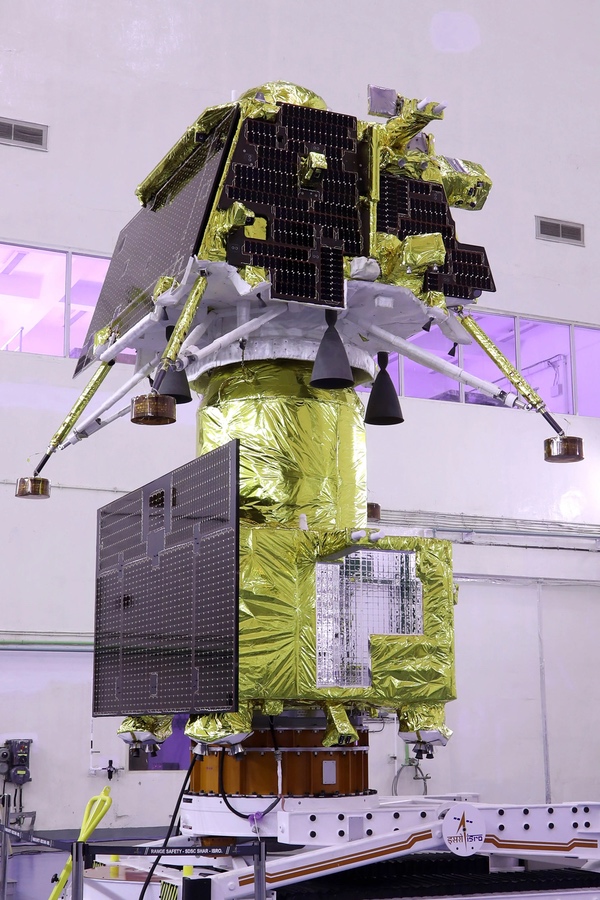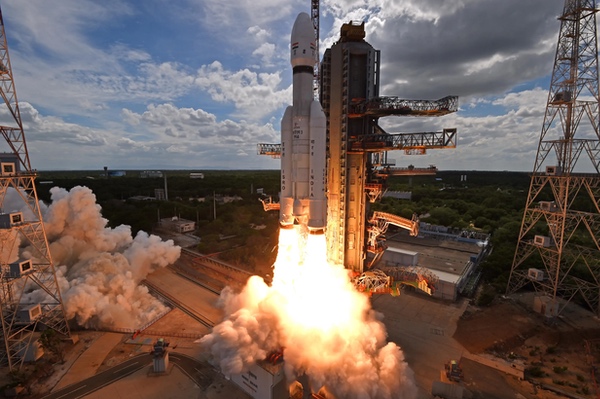The Chandrayaan-3 mission to the Moon is underwayby Ajey Lele
|
| Normally, ISRO makes public their investigation reports for failures during space missions. However, in the case of the Chandrayaan-2 disappointment, no failure assessment report has been made public. |
In that 2019 mission, ISRO’s craft took 30 days after launch to achieve lunar orbit insertion, and subsequently two more weeks for separation of the lander. Finally, the landing was attempted on the 48th day, which resulted in a failure. For the Chandrayaan-3 mission it is expected that the Moon landing will happen around August 23, a little more than a month after launch. It’s worth noting that this time ISRO has not launched any orbiter with this mission. The orbiter launched in 2019 is in good health and is expected to remain operational until 2026. Hence, all necessary support for this mission, like finalizing the exact landing location and supporting communications, would be provided by this orbiter.
Chandrayaan-3 mission has two main components: a Propulsion Module and a lander & rover unit (lunar module). ISRO identifies three main phases of this mission. The first phase is the Earth-centric phase and could be said to have begun with this successful launch. Some 16 minutes into the flight the spacecraft separation happened at a perigee of 180 km. ISRO wil undertake around five Earth orbit raising maneuvers, two of which have been completed as of July 17. Phase 2 is a lunar transfer phase as the spacecraft leaves Earth orbit to go to the Moon. The last phase will have different sub-phases, which mainly includes lunar orbit insertion, propulsion module and lunar module separation, and the landing attempt itself.
The structure of lunar module is nearly the same as the one flown on the Chandrayaan-2 mission. The earlier mission’s total mass was 3,877 kilograms, which includes the orbiter and lunar module. The Chandrayaan-3 mission weighs approximately 18 kilograms more. Since this mission doesn’t have an orbiter, ISRO had an opportunity to make the lander more robust. The Chandrayaan-3 lunar thus weighs 252 kilograms more.
ISRO has announced the details of the payloads that this mission is carrying. The propulsion module has single sensor for studying the spectro-polarimetric signatures of the Earth in near-infrared wavelengths. The lander has three payloads, while the rover has two. There is not much change in the nature of the payloads from what was carried on Chandrayaan-2. The instruments on the lander will carry out measurements for understanding the thermal properties of the lunar surface at its location. Also, there is a sensor to measure seismicity around the landing site and delineate the structure of the lunar crust and mantle below the surface. The Langmuir Probe will measure the near surface plasma density and its changes with time.
 The Chandrayaan-3 spacecraft, consisting of the lander (top) and propulsion module, during pre-launch preparations. (credit: ISRO) |
The rover payloads include an Alpha Particle X-Ray Spectrometer and Laser Induced Breakdown Spectroscope. Here the basic aim is to understand the chemical composition and elemental composition of lunar soil and rocks around the lunar landing site. There is also a plan to pierce a sensor into the surface of the Moon (to a depth of around ten centimeters) and measure the thermophysical characteristics of the lunar regolith.
This mission was undertaken by the LVM3 heavy-lift launch vehicle of ISRO. This was only the fourth mission for this rocket and hence it could be considered a new rocket. This is a three-stage launch vehicle consisting of two solid-propellant strap-ons, a liquid-propellant core stage, and a cryogenic upper stage. The previous two launches for this rocket were commercial launches carrying 36 satellites each for OneWeb, a UK-based company offering broadband satellite Internet services.
This mission is expected to land near the south pole region, at about 70 degrees south latitude. Until now most missions have landed around the Moon’s equatorial region. Technically, it is more challenging to land close to the south pole since the area has big craters and some completely shadowed areas. Hence, there are limited choices for a landing site. ISRO has designed the spacecraft keeping those aspects in mind. ISRO is keen to land close to the south pole because it would allow them to do more science. The cold traps around the south polar region could harbor deposits of water ice and other volatiles of great interest to science and human exploration.
In 2008, during the Chandrayaan-1 orbiter mission, ISRO released its Moon Impact Probe (MIP) from the orbiter close the Shackleton Crater at the lunar south pole. Some observations were picked up during this intentional hard-landing there, and MIP is the first human-made object to reach that area.
| So far only the US, the former Soviet Union, and China had succeeded with Moon landing missions. By the last week of August, we should know if India will join that coveted club. |
Normally, ISRO makes public their investigation reports for failures during space missions. However, in the case of the Chandrayaan-2 disappointment, no failure assessment report has been made public. There have been some official indications that one of the main reasons for the failure was a software glitch. It is known that the lander followed a normal path until reaching an altitude of 2.2 kilometers above the landing zone. Subsequently, communication with the lunar module was lost. There is a possibility that the trajectory deviation could have arisen between 2.1 and 0.2 kilometers above the landing zone. The lander had five engines for velocity reduction, and here higher thrust than required could have been generated, causing a loss in stability. The system witnessed an accumulation of errors and the software was not trained to handle several parameter dispersions.
This time ISRO has taken numerous precautions to ensure that no glitches take place. Some software and hardware changes have been made and a lot of testing and simulations have been carried out. Various scenarios have been generated to understand wider dispersions that may happen. Algorithms are built based on diverse possibilities leading to problems in the mission, and various alternative solutions have been worked out and incorporated into the system. Since the lunar module for this mission is heavier than the earlier mission, the landing system has one additional engine. Also, more fuel has been carried for any last-minute challenges.
Much of groundwork has already happened to select the landing location based on the data received by the Chandrayaan-2 orbiter. As the mission approaches the Moon, fresh images will be provided by the orbiter. There is software available to compare the earlier imagery and the recent imagery. Finally, the system will make the decision for the landing area. As such, a landing zone with a bigger area has been already identified, providing more options for the lander to land than for Chandrayaan-2’s lander.
Two private missions have attempted soft landings on the lunar surface. Unfortunately, both these missions were unsuccessful. Israel’s SpaceIL crashed while landing in April 2019 while Japanese company ispace also crashed during a landing attempt this past April. The Japanese company had carried two rovers, of which one was for the United Arab Emirates (UAE). The Israeli agency has decided to continue with their Beresheet program and is planning for its second mission as soon as 2025.
Reaching the Moon is not an easy proposition. So far only the US, the former Soviet Union, and China had succeeded with Moon landing missions. By the last week of August, we should know if India will join that coveted club.
Note: we are using a new commenting system, which may require you to create a new account.
